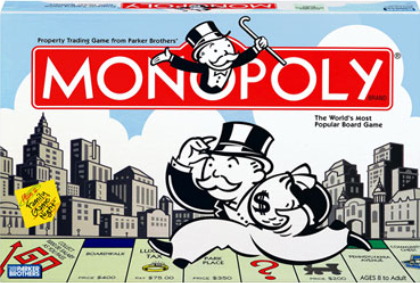

The origins of Monopoly lie within the early 1900s with Lizzie Magie.
#MONOPOLY HISTORY FULL#
Oh no, no, no, you can’t play any more because even with all your stuff, it doesn’t come close to what you owe me.’” Obviously children cannot grasp the full meaning of Monopoly, but that’s because they were not the target audience at first. I look her dead in the face and say, ‘You see all your properties and houses and all your money? That’s mine now. explained what generally happened every time he and his daughters played the game together: “My six-year-old totally understands Monopoly but she isn’t quite ready for the emotional trauma of her inevitable loss. The gameboard is divided into street names, banks, restaurants, and hotels, and other properties that players are expected to acquire throughout the game.Did you know that the game Monopoly was supposed to show players the negative aspects of private monopolies? With topics such as the stock exchange, bankruptcy, mortgaging, and jail, we probably should have seen how realistic this game is. There are also the instruction cards composed of a railroad, community chest, chance, and title deed designs. These represent the following: battleship, cannon, dog, horse and rider, race car, whose, thimble, top hat, and wheel barrow. The traditional monopoly game pieces, originally from wood changed to tin until they settled on the now-familiar plastic-made pieces. The game ends when all other players are bankrupt leaving only one player with money and property owned. Chance and community chest cards allow players to buy up other owned properties, sell, or trade depending upon the card instructions. But landing on an owned piece means paying rent and dues as a dictated property title deed. Landing on the property without an owner gives the player an option to buy. Rolling double means a player gets a 2nd turn but a double roll 3 times in a row lands the player’s token in jail. Subsequent game space moves also depend upon the dice roll. The order of playing is decided by the roll of the dice. Everything else belongs to the bank and can be borrowed by the player at given times. Then the banker distributes cash in individual amounts of $1,$5, $10, and six $20 bills. Intended for 2-8 players, the game begins by having each player choose a representative token. The board game is divided into property types and street names which remain unsold and without owners at the start of the game. The main objective of the game is to be the person with the most money and properties at the end of the game, thus turning the town into a Monopoly rule. For example, Magie settled for a royalty payment stemming from a limited period of manufacturing of her version of the board game. Most of these cases were either settled out of court or through legally binding contractual agreements with the other parties. spent most of the company time and money in court, suing the other game developers who laid claim to the game concept and design.
#MONOPOLY HISTORY LICENSE#
Some of the other people laying claim to the invention of the game are Ruth Hoskins and Louis Thun.ĭue to all the various versions of the game, license owner Parker Bros. Then, we also have the game “Finance” which was a variation on the game by Dan Layman from Indianapolis.

While Darrow’s objective was to monopolize the control of one area, Magie instead wanted to teach people about how a single tax system could work for them. There was also a difference in the game objective.


 0 kommentar(er)
0 kommentar(er)
